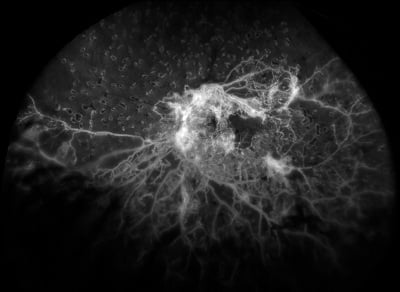If you suffer from type 1 or type 2 diabetes, you’re at a higher risk for eye conditions that may lead to blindness. One of these conditions is diabetic retinopathy.

This disease occurs as the blood vessels providing nourishment to the retina begin to leak blood and other fluids. Abnormal blood vessels may begin to grow on the surface of the retina. This damage causes the retina to swell and cloud your vision as it progresses through its four identifiable stages to blindness.
Four Stages of Diabetic Retinopathy
- **Stage One — Mild nonproliferative retinopathy. In the earliest stage, small aneurysms cause balloon-like swelling in the tiny blood vessels of the retina.
- **Stage Two — Moderate nonproliferative retinopathy. The condition progresses and some blood vessels in the retina become blocked, cutting off nourishment to the retina.
- **Stage Three — Severe nonproliferative retinopathy. The retina becomes starved of its blood supply as more blood vessels become blocked. As a result, signals are sent to the body to grow new blood vessels and increase blood supply.
- **Stage Four — Proliferative retinopathy. The body responds to the call for additional blood vessels by producing abnormal blood vessels on the retina and the vitreous gel within the eye. These new vessels are fragile and can leak, leading to macular edema.
How You Can Reduce Your Risk
Your risk for diabetic retinopathy increases the longer you have diabetes, but by keeping your blood sugar levels under control, you can reduce your risk. Left untreated, this condition can deteriorate vision and result in blindness. It’s difficult to detect diabetic retinopathy in its early stages because patients do not experience visual symptoms at the onset.
If you have diabetes, it’s recommended you have a comprehensive eye exam once a year or whenever you notice a change in your vision. Early detection and treatment will help reduce your vision loss from diabetic retinopathy. And if you’re looking a clinic that utilizes the most cutting-edge retinal imaging technology, be sure to ask them if they’re utilizing optomap ultra-widefield retinal imaging devices.
Image Source: Optos